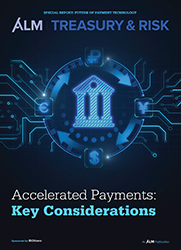
Like the transactions they enable, new payment capabilities are hitting the market at an accelerating pace. While many corporate treasury functions are focused on the launch of the FedNow service next spring, other options also warrant attention as the universe of accelerated-payment offerings expands. It makes sense for treasury leaders to develop evaluation criteria for assessing different options, including Real-Time Payments (RTP) and Same-Day ACH.
Nathan Hilt, a Protiviti managing director who leads the firm's payments and fintech solutions practice, is watching closely to see how large and midsize banks, as well as financial technology (fintech) firms, leverage FedNow. He also believes that blockchain and cryptocurrencies—including central bank digital currencies (CBDCs) and stablecoins—remain interesting, and viable, means to rapidly settle transactions.
Hilt views different modes of accelerated payments not as a single, absolute treasury solution, but as options that can meet different needs. That perspective is shared by other payments experts—and it explains why Prashant Patri, a Deloitte Risk & Financial Advisory principal, advocates making platforms "payment-type agnostic."
"The goal is to fit the use case to the processing capability and the ecosystem that would support the various payment methods," Hilt says. "I don't think there will be, or ever is, a 'one size fits all,' so there is a continued need and business case for various accelerated-payment methods."
Ernst & Young LLP partner/principal Jen Lucas, who leads her firm's Americas consulting payments practice, encourages corporate treasury leaders to monitor banks' adoption of faster payment rails tailored to specific vertical industry segments, such as automotive, insurance, and healthcare. These strategies often include related services as well. "Other notable offerings include cash flow forecasting with aggregated payments data," Lucas reports, "and developing and introducing partnerships with third parties for integrated payables and receivables experiences."
Beyond business-to-business (B2B) accelerated payments, some organizations, including very small companies, are leveraging business-to-consumer (B2C) solutions. The use of B2C payment technologies in larger companies remains in "early stages," according to Patri. "In several sectors, companies are easing payment guardrails to enable better customer experience," he notes. "For instance, some retailers have developed app-based payment tools that allow consumers to use their phone for transactions. In the insurance industry, some insurers have begun settling claims payments directly into customer e-wallets to replace dependency on check processing."
Given the increase in accelerated-payment technologies and services, treasurers should keep the following in mind when weighing their options:
- This is a work in progress. Companies and banks are "still working through legacy issues related to straight-through processing, visibility, expectation management, and pricing considerations," Hilt emphasizes. "The new options for real-time, same-day, and other faster payments certainly help with many of these challenges." Yet he also notes that, for treasury functions, "having, or building, the necessary integrations is crucial to realizing the overall benefits."
- Look beyond speed. Faster payments are valuable, but other factors also should be evaluated, stresses Strategic Treasurer managing partner Craig Jeffery. "Making payments better from a visibility perspective is part of the comprehensive value proposition," he notes, while pointing out that efficiency, control, and cost also require consideration. "The evaluation should normally begin with the end-to-end view of value for all parties," Jeffery adds. "Optimizing a single component will suboptimize the entire value transfer process."
- Controls are required. "Treasury leaders should consistently evaluate and have controls in place for risk and fraud, especially around email compromises and social engineering," Lucas notes. Hilt agrees, stressing that compliance and fraud considerations should be factored into payment processes, as well as supporting technologies and the systems those applications interact with.
"I think it's encouraging that the range of products, services, and providers continues to grow for treasurers," Hilt adds, "and that they have a variety of viable options to achieve their straight-through processing objectives."
See also:

- November 2022 Special Report
- The Pros and Cons of New Digital Payment Options
- Next-Level Efficiency Opportunities for A/R and A/P
- Payment Innovations on the Horizon
Eric Krell's work has appeared previously in Treasury & Risk, as well as Consulting Magazine. He is based in Austin, Texas.
© 2025 ALM Global, LLC, All Rights Reserved. Request academic re-use from www.copyright.com. All other uses, submit a request to [email protected]. For more information visit Asset & Logo Licensing.





